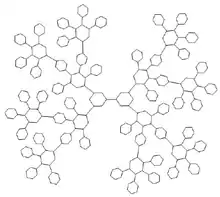Padmakar–Ivan index
In chemical graph theory, the Padmakar–Ivan (PI) index is a topological index of a molecule, used in biochemistry. The Padmakar–Ivan index is a generalization introduced by Padmakar V. Khadikar and Iván Gutman[1] of the concept of the Wiener index, introduced by Harry Wiener. The Padmakar–Ivan index of a graph G is the sum over all edges uv of G of number of edges which are not equidistant from u and v. Let G be a graph and e = uv an edge of G. Here denotes the number of edges lying closer to the vertex u than the vertex v, and is the number of edges lying closer to the vertex v than the vertex u. The Padmakar–Ivan index of a graph G is defined as
The PI index is very important in the study of quantitative structure–activity relationship for the classification models used in the chemical, biological sciences, engineering, and nanotechnology.
References
- Padmakar, V. Khadikar.; Sneha, Karmarkar; Vijay K., Agrawal (2001), "A Novel PI Index and Its Applications to QSPR/QSAR Studies", J. Chem. Inf. Comput. Sci., 41 (4): 934–949, doi:10.1021/ci0003092, PMID 11500110.
- Khalifeh, M.H.; Darafsheh, M.R; Jolany, H. (2011), "The Wiener, Szeged, and PI Indices of a Dendrimer Nanostar", Journal of Computational and Theoretical Nanoscience, 8 (2): 220–223, Bibcode:2011JCTN....8..220K, doi:10.1166/jctn.2011.1681.
